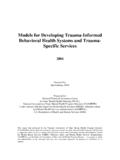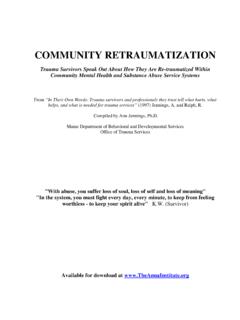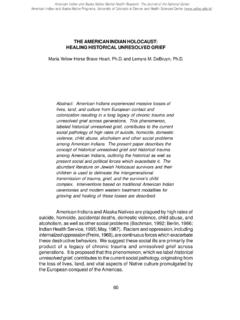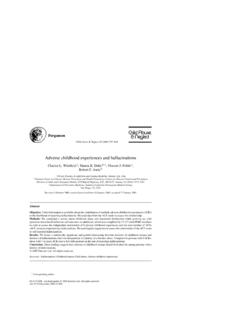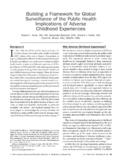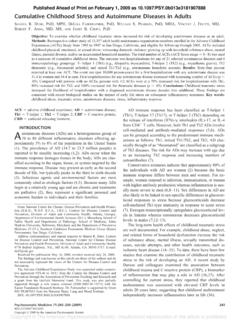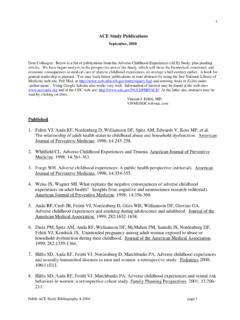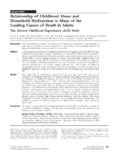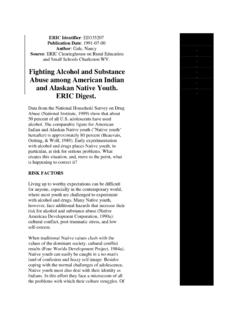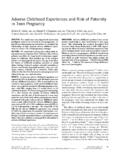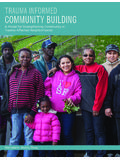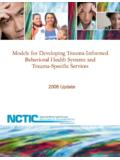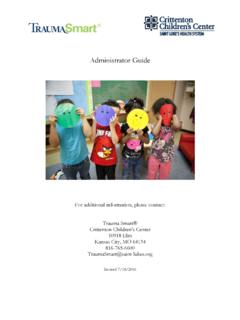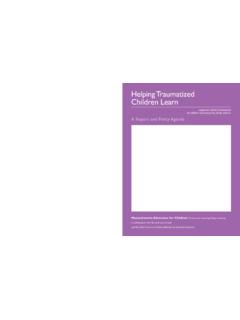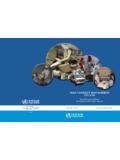Transcription of Domain 1. Program Procedures and Settings: “To …
1 trauma - informed Program Self-Assessment Scale Version (5-06) community Connections (DRAFT: Not for circulation without permission) Roger D. Fallot, & Maxine Harris, For information: or Rebecca Wolfson Berley; 1 Domain 1. Program Procedures and Settings: To what extent are Program activities and settings consistent with five guiding principles of trauma - informed practice: safety, trustworthiness, choice, collaboration, and empowerment? Domain 1A. Safety Ensuring Physical and Emotional Safety: To what extent do the Program s activities and settings ensure the physical and emotional safety of consumers and staff? Criterion 1 2 3 4 5 1. Program Review: The Program has conducted a specific and systematic review of its physical setting and its activities in order to evaluate its physical and emotional safety and to make changes necessary to ensure consumer and staff safety.
2 No specific, systematic review has been conducted. A systematic Program -wide review has been conducted, including both consumer-survivor and line staff input. In addition to (2), an action plan to maximize safety has been developed. In addition to (3), the action plan has been partially implemented. In addition to (4), all steps of the action plan have been implemented. 2. Incident Review: The Program systematically reviews those incidents that indicate a lack of safety ( , verbal and physical confrontations, assaults) and makes changes to prevent their recurrence. No incident reviews have occurred. A plan has been developed for identifying and reporting incidents that indicate a lack of safety (incl. both consumer and staff reports).
3 In addition to (2), a plan has been developed for clinical and administrative review of incidents that indicate a lack of safety. In addition to (3), the plan has been implemented. In addition to (4), the incident reviews are used to modify potentially unsafe practices or settings. 3. Consumer Ratings of Safety: In Program satisfaction surveys, consumers rate Program safety at the agree (or comparable, better than neutral) point on the rating scale or higher. No consumers rate Program safety at the agree or higher point. Fewer than 40% of consumers rate Program safety at the agree or higher point. 40-70% of consumers rate Program safety at the agree or higher point. 71-90% of consumers rate Program safety at the agree or higher point.
4 More than 90% of consumers rate Program safety at the agree or higher point. 4. Staff Ratings of Safety: In staff surveys, staff rate Program safety at the agree or comparable point on the rating scale or higher. No staff members rate Program safety at the agree or higher point. Fewer than 40% of staff members rate Program safety at the agree or higher point. 40-70% of staff members rate Program safety at the agree or higher point. 71-90% of staff members rate Program safety at the agree or higher point. More than 90% of staff members rate Program safety at the agree or higher point. trauma - informed Program Self-Assessment Scale Version (5-06) community Connections (DRAFT: Not for circulation without permission) Roger D.
5 Fallot, & Maxine Harris, For information: or Rebecca Wolfson Berley; 2 Domain 1B. Trustworthiness Maximizing Trustworthiness through Task Clarity, Consistency, and Interpersonal Boundaries: To what extent do the Program s activities and settings maximize trustworthiness by making the tasks involved in service delivery clear, by ensuring consistency in practice, and by maintaining boundaries that are appropriate to the Program ? Criterion 1 2 3 4 5 1. Program Review: The Program has conducted a specific and systematic review of its physical setting and activities in order to evaluate factors related to Program trustworthiness (esp. clear tasks, consistent practices, and staff-consumer boundaries) and to make changes necessary to ensure that trustworthiness is maximized.
6 (Peer-run programs usually have different boundary concerns than those with professional staffs; they need to adjust the understanding of trustworthiness accordingly. See Self-Assessment and Planning Protocol.) No specific, systematic review has been conducted. A systematic Program -wide review has been conducted, including consumer-survivor input. In addition to (2), an action plan to maximize Program trustworthiness has been developed. In addition to (3), the action plan has been partially implemented. In addition to (4), all steps of the action plan have been implemented. 2. informed Consent: The Program reviews its services with each prospective consumer, based on clear statements of the goals, risks, and benefits of Program participation, and obtains informed consent from each consumer.
7 No consumers have provided informed consent for service participation. Fewer than 30% of consumers have provided informed consent. 30-60% of consumers have provided informed consent. 61-90% of consumers have provided informed consent. More than 90% of consumers have provided informed consent. 3. Review of Alleged Boundary Violations: The Program has a clear procedure for the review of any allegations of boundary violations, including sexual harassment and inappropriate social contacts. No policy exists regarding review of alleged boundary violations. A plan has been developed for identifying and reporting incidents that indicate possible boundary violations. In addition to (2), a plan has been developed for clinical and administrative review of alleged boundary violations In addition to (3), the plan has been implemented.
8 In addition to (4), the incident reviews are used to modify practices that may lead to boundary violations. 4. Consumer Ratings of Trust and Clarity of Tasks and Boundaries: Consumers rate the Program and its staff as trustworthy offering clear information and maintaining appropriate professional relationships at the agree (or comparable, better than neutral) point on the rating scale or higher. No consumers rate Program trustworthiness at the agree or higher point. Fewer than 40% of consumers rate Program trustworthiness at the agree or higher point. 40-70% of consumers rate Program trustworthiness at the agree or higher point. 71-90% of consumers rate Program trustworthiness at the agree or higher point. More than 90% of consumers rate Program trustworthiness at the agree or higher point.
9 trauma - informed Program Self-Assessment Scale Version (5-06) community Connections (DRAFT: Not for circulation without permission) Roger D. Fallot, & Maxine Harris, For information: or Rebecca Wolfson Berley; 3 Domain 1C. Choice Maximizing Consumer Choice and Control. To what extent do the Program s activities and settings maximize consumer experiences of choice and control? Criterion 1 2 3 4 5 1. Program Review: The Program has conducted a specific and systematic review of its physical setting and its activities in order to evaluate consumer choice and control and to make changes necessary to maximize consumer choice. No specific, systematic review has been conducted. A systematic Program -wide review has been conducted, including consumer-survivor input.
10 In addition to (2), an action plan to maximize consumer choice has been developed. In addition to (3), the action plan has been partially implemented. In addition to (4), all steps of the action plan have been implemented. 2. Program Options: Staff review the Program s service options ( , types of services offered, locations, housing possibilities, choices regarding clinicians) with each consumer prior to the development of an initial service plan. Service options have been reviewed with no consumers. Fewer than 30% of consumers have reviewed the Program s service options with staff. 30-60% of consumers have reviewed the Program s service options with staff. 61-90% of consumers have reviewed the Program s service options with staff.
